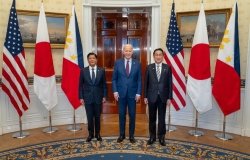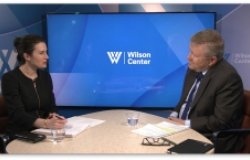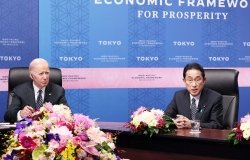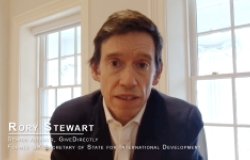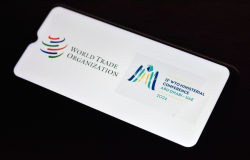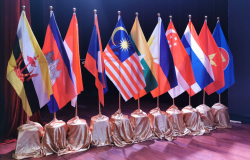Critical Dialogues on Avian Influenza
At an event co-sponsored by the Wilson Center and Cornell University, public health, animal health, and wildlife management experts emphasize that preventing a pandemic will require a strong international health alliance that addresses animal as well as human health.
Overview
As the H5N1 avian flu strain continues to travel west, ravaging bird populations from East Asia to Europe, national governments and international health bodies are scrambling to develop policy responses and coordinate a dizzying array of experts and officials. At a recent event co-sponsored by the Wilson Center and Cornell University, representatives from the public health, animal health, and wildlife management communities came together to emphasize that preventing a pandemic will require a strong international health alliance that addresses animal as well as human health.
Alfonso Torres, executive director of the Animal Heath Diagnostic Center and associate dean of veterinary public policy at Cornell University's College of Veterinary Medicine, began the conference with an overview of avian influenza and the factors that interact to create diseases. "In order to have infectious diseases," he said, "we have to have a minimum of these three factors: an agent, a host, and an environment." With avian influenza, the agent of most immediate concern is H5N1, and the waterfowl and shorebird populations are the hosts. According to Torres, the natural reservoir of all subtypes of avian influenza is the bird population, where there are at least 4 families and 161 species of waterfowl, and 14 families and more than 20 species of shorebird. Lastly, the environment—the backdrop upon which the agent and host interact—is Southeast Asia.
With its growing population and the close proximity of people to animals, Southeast Asia provides an environment where influenza viruses can be easily shared between animal and people. Noting that globally, animal protein production increases when economies expand, Torres said that production of poultry will grow the most, especially in Southeast Asia and the rest of the developing world. "Why poultry? Because it's quicker and more efficient to provide protein through chickens rather than other animals." To this end, he noted, developing countries will generate 60 percent of the world's meat and 52 percent of its milk by 2020. "This will lead to an increase in the possibility of diseases coming to us from the developing world." Dealing with zoonotic diseases, which originate in animals but can be transmitted to humans, will require a coordinated approach among different sectors, Torres said.
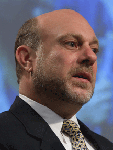 William Karesh, director of Wildlife Conservation Society's Field Veterinary Program, discussed ways to minimize human risk from zoonotic diseases. Asia, especially, needs an "upstream approach," a proactive effort to teach people about the behaviors and customs that make them more susceptible to disease, Karesh noted. Showing a photograph of a woman sleeping with her arms around a peacock, he noted that animal practices in other countries often differ wildly from those of the United States. "In most poor countries, animals are mixed with people; and you have a constant mix of bacteria and viruses," he said.
William Karesh, director of Wildlife Conservation Society's Field Veterinary Program, discussed ways to minimize human risk from zoonotic diseases. Asia, especially, needs an "upstream approach," a proactive effort to teach people about the behaviors and customs that make them more susceptible to disease, Karesh noted. Showing a photograph of a woman sleeping with her arms around a peacock, he noted that animal practices in other countries often differ wildly from those of the United States. "In most poor countries, animals are mixed with people; and you have a constant mix of bacteria and viruses," he said.
This constant mix of animals and bacteria is made worse by the pet trade. According to Karesh, a Thai market his team studied sold upwards of 70,000 birds from more than 276 species over a period of 25 weekends. The trade routes, he said, are incredibly diverse, as animals are brought in from the wild, moved to hubs, then shipped to final destinations around the world. "You can see the potential for problems," he said. "It's going to require a lot of education and sincere effort to prevent [diseases from spreading]."
Modern planes have made it possible for people—and animals—to move around the world swiftly. But such convenience has also allowed diseases to spread across continents in a matter of hours. To combat this, Karesh underscored the need for an early warning system for wildlife and wildlife diseases. "No one agency, no one government is going to be able to do this," he said. An international health alliance that factors in human health as well as animal health will be key in staving off the next pandemic. "The concept we have is ‘one world, one health.' There is the division of human health and wildlife health. But really, there's only one health."
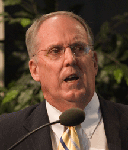 Spangler "Buzz" Klopp, a corporate veterinarian for poultry company Townsends, Inc., provided insight on how the U.S. poultry industry might be affected by the pandemic. "Look at our domestic industry in terms of food," he said. "Each year the average person consumes 253 eggs, 16 pounds of turkey, and 87 pounds of chicken." To address the threat of disease spreading through the international pet trade, as well as through regular bird migration, Klopp said the U.S. poultry industry has created new means of protecting its assets. "Early detection without quick and aggressive action doesn't really do anything," he said. "If there's one thing I learned it's that you treat [avian influenza] with humility and respect because you don't know what it's going to do."
Spangler "Buzz" Klopp, a corporate veterinarian for poultry company Townsends, Inc., provided insight on how the U.S. poultry industry might be affected by the pandemic. "Look at our domestic industry in terms of food," he said. "Each year the average person consumes 253 eggs, 16 pounds of turkey, and 87 pounds of chicken." To address the threat of disease spreading through the international pet trade, as well as through regular bird migration, Klopp said the U.S. poultry industry has created new means of protecting its assets. "Early detection without quick and aggressive action doesn't really do anything," he said. "If there's one thing I learned it's that you treat [avian influenza] with humility and respect because you don't know what it's going to do."
According to Klopp, the best security system to avoid disease is vertical integration, whereby every process—from incubation and hatching, to the eventual delivery to the grocery store—is contained to avoid contamination from unclean sources. The entire production process is tracked and monitored to spot any irregularities or problems. Under this system, Klopp said the only outside influences are the stock providers and the feed ingredients. "Everything within the scenario is contained and managed by USDA standards," he said. "This is our fundamental means of biosecurity. The practices that have evolved in our production system didn't just happen—they evolved out of the school of hard knocks. We tried a lot of things that didn't work."
Part of the biosecurity plan requires that poultry producers not breed backyard—or "free range"—birds. "There is a mental concept that a free-range bird is a clean bird," Klopp said. "But if we look at the most recent sources of avian influenza in the United States, we can go back to the free-range bird." Allowing domesticated birds outdoor access allows them to interact with other birds and animals, which may have diseases. According to Klopp, the easiest way of keeping U.S. poultry clean is to keep it within contained facilities and without access to wildlife. "The markets have done a good job of cleaning themselves up," he said. "But we need to be mindful of the commingling that goes on in these establishments."
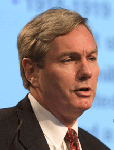 Michael Osterholm, director of the Center for Infectious Disease Research and Policy and associate director of the National Center for Food Protection and Defense at the University of Minnesota, followed up on his September 19, 2005 talk on avian flu at the Wilson Center by emphasizing that people—both the media and the general public—need to understand the distinction between seasonal influenza and pandemic-related disease. Seasonal disease occurs after pandemic threat has already passed, whereas a pandemic occurs when a novel viral agent emerges. And for a pandemic to occur, the emerging viral strain needs to be readily transmittable between humans. The H5N1 strain, Osterholm noted, shows great similarities to the 1918 Spanish flu, which has traditionally been estimated to have killed 25-50 million people, although recent data indicates it could have been as high as 100 million. "Traditional influenza pandemics have ‘U' shaped mortality curves with death rates in the very young and the very old," he said. But in the case of 1918—and in the known human cases of H5N1—the "U" shape curve has shifted to a "W," disproportionately affecting the healthiest segments of the population.
Michael Osterholm, director of the Center for Infectious Disease Research and Policy and associate director of the National Center for Food Protection and Defense at the University of Minnesota, followed up on his September 19, 2005 talk on avian flu at the Wilson Center by emphasizing that people—both the media and the general public—need to understand the distinction between seasonal influenza and pandemic-related disease. Seasonal disease occurs after pandemic threat has already passed, whereas a pandemic occurs when a novel viral agent emerges. And for a pandemic to occur, the emerging viral strain needs to be readily transmittable between humans. The H5N1 strain, Osterholm noted, shows great similarities to the 1918 Spanish flu, which has traditionally been estimated to have killed 25-50 million people, although recent data indicates it could have been as high as 100 million. "Traditional influenza pandemics have ‘U' shaped mortality curves with death rates in the very young and the very old," he said. But in the case of 1918—and in the known human cases of H5N1—the "U" shape curve has shifted to a "W," disproportionately affecting the healthiest segments of the population.
Despite these similarities, Osterholm said that no one can predict whether H5N1 will be the source of the next pandemic. But he noted that pandemics have occurred throughout history, and have averaged one every 24 years over the last 300 years. "There's one thing I want to emphasize more than anything: pandemics are not options. We can't prevent pandemics today. They have occurred all the way back to antiquity," he said.
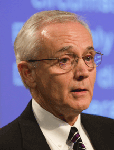 Lonnie King, dean of Michigan State University's College of Veterinary Medicine, continued in the same vein as Osterholm, noting that "pandemics happen" and that "a lethal virus is indeed evolving." In Southeast Asia, King said that H5N1 is already endemic in poultry and birds. Further, King showed a slide of the World Health Organization's Global Influenza Preparedness Plan and noted that the virus has already met the criteria of four of the six phases in the plan, with six being an actual pandemic. Due to the escalating phases, governments have begun creating pandemic plans for their citizens. Of the many plans made public, King said that "some of them are practical. Some of them are pragmatic. And some of them will never work." For instance, he noted that bird vaccinations may be impractical given the tens of billions of birds alive in China at any given time: "When do you stop vaccinating?"
Lonnie King, dean of Michigan State University's College of Veterinary Medicine, continued in the same vein as Osterholm, noting that "pandemics happen" and that "a lethal virus is indeed evolving." In Southeast Asia, King said that H5N1 is already endemic in poultry and birds. Further, King showed a slide of the World Health Organization's Global Influenza Preparedness Plan and noted that the virus has already met the criteria of four of the six phases in the plan, with six being an actual pandemic. Due to the escalating phases, governments have begun creating pandemic plans for their citizens. Of the many plans made public, King said that "some of them are practical. Some of them are pragmatic. And some of them will never work." For instance, he noted that bird vaccinations may be impractical given the tens of billions of birds alive in China at any given time: "When do you stop vaccinating?"
King noted that last year more than 21 billion food animals fed a population of more than 6 billion people, resulting in trillions of pounds of products. "One of my colleagues calls this the microbial Club Med era," King said. "It's a good time to be a microbe. Just think about the possibilities." Like the other speakers, King concluded that animal health and public health strategies and actions must be integrated. "We have to build infrastructures in health systems in developing countries—not just human health, but animal health too. Vaccines and antivirals are important responses but are not long-term solutions."
Drafted by Alison Williams.
Documents & Downloads
- Critical Dialogues on Avian InfluenzaDownload
- Critical Dialogues on Avian InfluenzaDownload
- Critical Dialogues on Avian InfluenzaDownload
- Critical Dialogues on Avian InfluenzaDownload
- Critical Dialogues on Avian InfluenzaDownload
- Critical Dialogues on Avian InfluenzaDownload
- Critical Dialogues on Avian InfluenzaDownload
- Critical Dialogues on Avian InfluenzaDownload
- Critical Dialogues on Avian InfluenzaDownload
Speakers
Alfonso Torres
William Karesh
Spangler "Buzz" Klopp
Michael Osterholm
Lonnie King
Hosted By

Maternal Health Initiative
Life and health are the most basic human rights, yet disparities between and within countries continue to grow. No single solution or institution can address the variety of health concerns the world faces. By leveraging, building on, and coordinating the Wilson Center’s strong regional and cross-cutting programming, the Maternal Health Initiative (MHI) promotes dialogue and understanding among practitioners, scholars, community leaders, and policymakers. Read more

Environmental Change and Security Program
The Environmental Change and Security Program (ECSP) explores the connections between environmental change, health, and population dynamics and their links to conflict, human insecurity, and foreign policy. Read more

Indo-Pacific Program
The Indo-Pacific Program promotes policy debate and intellectual discussions on US interests in the Asia-Pacific as well as political, economic, security, and social issues relating to the world’s most populous and economically dynamic region. Read more
Thank you for your interest in this event. Please send any feedback or questions to our Events staff.
